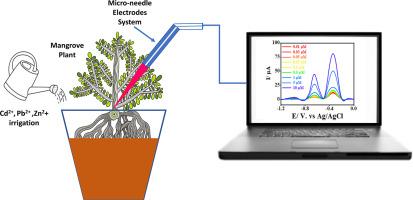Integrated electrochemical and spectroscopic assessment of heavy metal bioaccumulation in mangrove plants: A sustainable strategy for environmental monitoring and risk mitigation
IF 7.7
Q2 ENGINEERING, ENVIRONMENTAL
引用次数: 0
Abstract
Mangrove forests play a vital role in coastal protection, biodiversity, and pollution mitigation, but they are increasingly threatened by heavy metal uptake associated with industrialization. However, real-time, in-situ, and non-destructive methods for monitoring metal bioavailability within mangrove plants remain unavailable. This study develops and tests an acupuncture Needle Electrode modified with reduced graphene oxide and bismuth nanoparticles (ANE/rGO/BiNPs) for real-time heavy metal detection in Alhamriyah Mangrove Reserve (AHMR). To establish baseline contamination levels for a range of elements, water and sediment samples were collected from three sites within the reserve and analyzed using inductively coupled plasma optical emission spectrometry (ICP-OES). The chemical oxygen demand (COD) was high (> 11.0 mg/L), and the sludge was quite polluted with Cd, In, Ag, and Bi as the contamination factor (Cf > 10). Analysis of a mature mangrove tree showed highest metal accumulation in roots, with contamination factors: In (870.460) > Ag (636.386) > Cd (416.588) > Bi (248.918) > Tl (93.144), suggesting industrial sources and highlight the need for monitoring non-traditional metals like Cd. Mangrove seedlings were irrigated with varying levels of Cd, Pb, and Zn, showing dose-dependent metal accumulation. Roots primarily accumulated Cd and Pb, indicating phytostabilization potential, while Zn's higher mobility suggests suitability for phytoextraction. The ANE/rGO/BiNPs sensor was inserted into living mangrove tissues to detect metal uptake using Square Wave Voltammetry (SWV). After four weeks, electrochemical readings showed high accumulation levels (Cd: 5182.29 µM, Pb: 5076.25 µM, Zn: 41,998.50 µM) under high treatment. Compared to much lower ICP-OES values (Cd < 150, Zn < 3, Pb < 5), electrochemical contamination factors were significantly higher, demonstrating the sensor’s superior sensitivity and effectiveness for non-destructive, real-time monitoring of bioavailable metal uptake in mangroves. This novel approach highlights the potential of needle-based sensors as practical tools for in-situ biomonitoring and environmental risk assessment in vulnerable coastal ecosystems.

红树林植物重金属生物积累的电化学和光谱综合评估:环境监测和风险缓解的可持续战略
红树林在沿海保护、生物多样性和减轻污染方面发挥着至关重要的作用,但它们日益受到与工业化有关的重金属吸收的威胁。然而,实时、原位和非破坏性的监测红树林植物金属生物利用度的方法仍然不可用。本研究开发并测试了一种用还原氧化石墨烯和铋纳米颗粒(ANE/rGO/BiNPs)修饰的针刺针电极,用于Alhamriyah红树林保护区(AHMR)的实时重金属检测。为了建立一系列元素的基线污染水平,从保护区的三个地点收集了水和沉积物样本,并使用电感耦合等离子体光学发射光谱(ICP-OES)进行了分析。化学需氧量(COD)较高(> 11.0 mg/L),且以Cd、In、Ag、Bi为污染因子(Cf > 10)的污泥污染较严重。对一棵成熟的红树的分析显示,根部的金属积累最高,污染因子为:in (870.460) > Ag (636.386) > Cd (416.588) > Bi (248.918) > Tl(93.144),这表明了工业来源,并强调了监测Cd等非传统金属的必要性。红树幼苗用不同水平的Cd、Pb和Zn灌溉,显示出剂量依赖性的金属积累。根系主要积累Cd和Pb,表明植物稳定潜力,而Zn的高迁移率表明植物适宜提取。将ANE/rGO/BiNPs传感器插入活红树林组织中,采用方波伏安法(SWV)检测金属摄取。4周后,电化学读数显示,在高处理条件下,Cd: 5182.29µM, Pb: 5076.25µM, Zn: 41,998.50µM的积累水平较高。与较低的ICP-OES值(Cd < 150, Zn < 3, Pb < 5)相比,电化学污染因子显著较高,表明该传感器对红树林生物可利用金属吸收的非破坏性实时监测具有优越的灵敏度和有效性。这种新颖的方法突出了针状传感器作为脆弱沿海生态系统现场生物监测和环境风险评估实用工具的潜力。
本文章由计算机程序翻译,如有差异,请以英文原文为准。
求助全文
约1分钟内获得全文
求助全文
来源期刊

Journal of hazardous materials advances
Environmental Engineering
CiteScore
4.80
自引率
0.00%
发文量
0
审稿时长
50 days
 求助内容:
求助内容: 应助结果提醒方式:
应助结果提醒方式:


